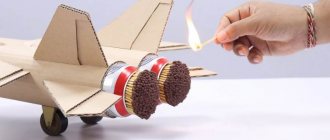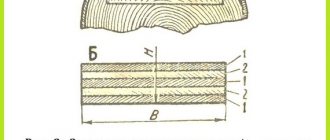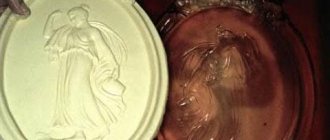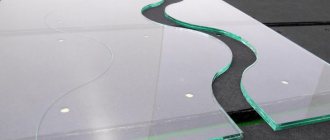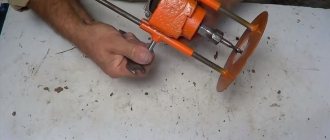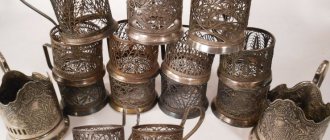Articles
All photos from the article
This article is about how to make a karambit from plywood: drawings and dimensions of a knife are easy to find online, but the technology for processing plywood to give the material maximum strength and an appearance that imitates a real weapon is unknown to many. It is to this that we will pay special attention.
Plywood karambit knife.
How to make karambit
In this article you will see pictures and drawings of a karambit knife, and also learn about the process of making a model from scrap materials.
The knife has a curved blade with a sharpening on the inside and a handle with a ring for the index finger.
A reverse grip is predominantly used, intended for ripping movements. Thanks to its unusual shape, karambit attracts the attention of ordinary people and bladed weapon lovers, and avid gamers will immediately recognize this remarkable knife. You can make it yourself, according to drawings, at home.
Application technique
Each weapon has its own characteristics and techniques of use. So, when using karambit, for greater efficiency you should adhere to the following techniques:
- it is important to create a distracting maneuver in time and, in the meantime, duck under the enemy’s arm and, with quick movements, deliver several cutting blows to the thigh;
- in this maneuver the ring plays the main role - if you hold on to it with your finger and quickly scroll, you can unexpectedly strike your opponent;
- it is necessary to quickly grab one of the attacker’s hands and with a quick blow inflict a wound in the forearm muscle.
Having quickly grabbed the attacker's hand, you need to hit the forearm muscle.
We became familiar with the techniques, and there are also two most common combat grips: forward and reverse.
The reverse grip is called characteristic, since the main interaction is associated with this grip. With it, the handle of the weapon is wrapped around all the fingers of the main hand, the ring is tightly placed on the index finger, and the blade is placed at the base of the fist.
The direct grip is used differently - the blade comes out of the hand from the thumb, the ring is located on the little finger.
Karambit knife: what kind of knife is it
Karambit differs from other knives in that it has a curved blade and sharpening on the inside.
The length of the karambit blade can be different - from five to nine centimeters. The key feature of this knife is the small ring on the handle, which is designed to make it more comfortable to hold the weapon in your hand and prevent it from slipping in the palm. The historical homeland of the karambit knife is the island of Sumatra. Local warriors of the Minangkabau tribe used such weapons in wars with other tribes.
A karambit knife can be bought in a specialized store, or you can make it yourself, both a real knife, made of metal, and a decorative karambit - made of paper, cardboard or wood. If you have not found a ready-made kit for making karambit, then for a future craft you will need to find a drawing of a karambit knife.
Artistic creativity
It’s not enough to know how to make a karambit from wood; you also need to paint it so that it looks like the real thing. There are several options for coloring (skins) of a knife in the game Counter-Strike: Global Offensive: from “Clear Water” to “Murder”. There are professional artists who, for a fee, manually paint models of karambits to look like real ones.
But you can try to paint your own karambit yourself. It is best to use acrylic paints - they mix well, are harmless, dry quickly and do not get dirty. The skin can be viewed on the CS:GO website, or you can come up with it yourself. The main thing is to turn on your imagination and desire to make a beautiful thing that looks like a real Tiger Claw knife. Good luck!
The history of knives dates back to the times when man first mastered the processing of materials. The first specimen was made of stone, although it is very difficult to call it a normal knife; it looked more like a scraper. Then metal casting was mastered, and the weapon began to take on a form closer to the modern one. A knife is an almost universal tool that can be used both for peaceful purposes, for example, for cooking, creating clothes and other products, and for military purposes - to resolve various kinds of conflicts.
From the history
This unique weapon has a rich history. The earliest mentions of karambit date back to the 12th century. But it is impossible to know the true history; it is shrouded in legends.
According to one of them, in parts of Indonesia, the local people had a cult of the tiger. People considered him a formidable jungle dweller. They thought that when they died, the souls of their kings transmigrated into the tiger. And the local population began to make combat knives, copying the appearance of a tiger claw. According to other versions, the blade originated either from the demon Bima, whose main weapon was claws, or from the king of the monkeys, who had a magical claw in his palm.
Most likely, the actual prototype of the blade was an ordinary sickle, and the hole was a necessity so that the object would not accidentally fall out of the hand. In these areas, the most common work was in the rice fields - in the water.
In ancient times, it was common on the Indonesian islands to smear the blade with strong poison. As a result of a small, lacerated wound, the enemy died instantly.
Along with heavy types of karambits, there were small ones - for domestic needs and self-defense.
The blade was made like this:
- carbon steel;
- the handle was made of wood or from the horn of an animal;
- the scabbard was made of wood, decorated, but did not have pendants; the blade was intended to be worn in the belt.
Karambit became the prototype of the Bulang blades, which were tied to the legs of roosters in cockfights.
Buy or make?
At the moment, you can find knives for every taste and budget; you can come across drawings of a knife made of plywood and plastic for those who are committed to making believable dummies. However, you can purchase a low-quality fake, even if you ordered a decorative version. There is nothing more reliable than an item made by the owner himself.
How to repair kitchen knives
Very often the handle of a favorite item breaks. Don’t rush to throw away your convenient blade; take some time to repair it.
Find a small piece of moisture-resistant plywood large enough to make the handle. Two fragments measuring 18x3x1 cm will do.
Also stock up on self-tapping screws, liquid nails glue, a file, emery cloth, varnish or paint:
- An original handle for a knife made from plywood with your own hands will be ideal if you initially make a template of the blank from paper or cardboard.
- Transfer the outline to the plywood dies, tracing the template with a pencil. You should end up with two identical wooden halves.
Marking the handle mounting points.
- The blanks are cut out and applied to the blade. Don't forget to mark where the screws will fit.
- To prevent the plywood knife from falling apart in your hand, the inside of the dies is smeared with glue, then a “sandwich” is assembled from the halves and the blade.
- The fitted parts are fastened with self-tapping screws and clamped in a vice for about a day. You can put the semi-finished product under a heavy press.
- After the glue has completely dried, the handle is finished with a file and emery cloth.
The photo shows the finished pen.
- In relation to household knives, the instructions advise covering the finished product with waterproof varnish or painting.
Note! Instead of fastening with self-tapping screws, you can rivet the handle. But the method is not available to everyone and is not so reliable. Threaded screws are held tighter, their heads are recessed and cleaned.
Legal assistant
Among the knives allowed by law to be worn and not considered edged weapons (with a blade length of up to 9 centimeters), there are also quite original and useful specimens. They have an affordable price and interesting appearance. For example, this is the “butterfly” of Filipino origin (the original name is “balisong”), the Malaysian-Indonesian knife “karambit” and the Nepalese “khukri”.
The last two have a strongly curved claw-shaped blade; the handle is often equipped with brass knuckles. The butterfly got its name thanks to the handle that extends in both directions, in which the blade is hidden when folded. When the arms open, they resemble wings.
How to make karambit from wood
The manufacturing scheme is simple: you need to find a suitable drawing - there are quite a few of them due to the wide variety of models. In addition, you need to sensibly evaluate your ability to work with wood or plywood. Then complete the blanks and fasten them.
The work is simple, but differs in a number of nuances.
- A drawing of karambit made of wood is transferred to cardboard or paper - this is how templates are obtained. Their number depends on the complexity of the model. In the simplest case, you will need 3 parts: the main part of the dagger - the blade and handle, and two figured attachments that provide a recognizable karambit relief.
- The templates are outlined with a pencil and cut out with a jigsaw or cutter. The latter takes quite a long time. The photo shows cutting with a jigsaw.
- The hole in the handle is cut with a feather drill. If you don’t have such a device, you can do the work with a jigsaw. To do this, pierce a through hole with an awl, then insert a file into the hole, attach it to a jigsaw and cut out the hole.
- The parts cut out according to the drawing are smeared with PVA glue and glued together. The structure is placed in a vice or clamped with a clamp until the glue dries completely - usually a day.
- Then the product is cleaned with sandpaper or a sander. The knife should be completely smooth. If there is a desire to make it more durable, then the workpiece is impregnated with bakelite glue.
- If the product is used in a role-playing game, it is painted as in the picture.
Manufacturing methods
How to make a CS GO dagger from paper, plywood, wood or plastic is clear from the pattern used for this, of which you can find many. In practice, they all come down to a few of the most popular methods, where the largest parts are made using ready-made templates and fastened together.
Game weapons, as a rule, are distinguished by their elaborate appearance and complex configuration. It is much easier to fulfill this condition using paper. But to do the same from plywood or wood, you will need experience. As easy as this material can be processed, it requires a lot of experience to produce delicate parts.
There are 2 methods of working according to do-it-yourself drawings.
- In the first case, the main part is cut out of a material 12 mm thick and 2 nozzles 4 mm thick are fixed. Assembly of the product is simpler, but a lot of work will be required to grind the blade down to give it a conical shape.
- In the second case, the CS GO dagger is assembled from 5 plates cut from a material 4 mm thick. This option exactly follows the contours of the weapon, but up close it looks far from the picture. However, the imitation of a knife serves its function in close combat. In the photo there is a knife made of wood.
Origin
Karambit comes from Sumatra, one of the Asian islands, where it was compared to a tiger's claw.
Indeed, the external resemblance of the blade is easily traced, and the blows inflicted by the weapon resemble the swings of the paw of an angry animal.
Its historical origin is still unclear. There are two main options. The first is that it was used in cockfights, tied as spurs so that the rooster would injure its opponent.
The second was a formidable hunting and combat knife of warriors from Malaysia. None of the options have been proven. The photo below shows what the prototype of a modern karambit looks like.
In video games
In general society, this knife gained popularity due to the Valve game called Counter Strike: Global Offensive. There, karambit is presented as a popular skin for a standard knife, it changes its appearance and animation.
The community immediately liked the skin, but most users did not have enough money for an in-game purchase. Because of this, most of the drawings are made specifically for karambit from cs go.
Here is a screenshot from the computer game CS:GO, which shows what a karambit looks like:
Drawing of karambit made of plywood
One of the most popular materials for making a karambit knife is plywood.
A plywood knife, of course, is not a real weapon, but it can be used in martial arts to practice techniques with weapons; the same weapon can also be used in role-playing games based on fantasy works, which are so popular among modern youth. Drawings for a karambit knife made of plywood can be the same as drawings for a knife made of metal. You just need to find a sketch of the blade and modify it to fit the finished dimensions. You can easily download drawings of a karambit knife from specific websites about weapons - there you can even find templates that are completely ready for use.
From the history
This unique weapon has a rich history. The earliest mentions of karambit date back to the 12th century. But it is impossible to know the true history; it is shrouded in legends.
According to one of them, in parts of Indonesia, the local people had a cult of the tiger. People considered him a formidable jungle dweller. They thought that when they died, the souls of their kings transmigrated into the tiger. And the local population began to make combat knives, copying the appearance of a tiger claw. According to other versions, the blade originated either from the demon Bima, whose main weapon was claws, or from the king of the monkeys, who had a magical claw in his palm.
Most likely, the actual prototype of the blade was an ordinary sickle, and the hole was a necessity so that the object would not accidentally fall out of the hand. In these areas, the most common work was in the rice fields - in the water.
In ancient times, it was common on the Indonesian islands to smear the blade with strong poison. As a result of a small, lacerated wound, the enemy died instantly.
Along with heavy types of karambits, there were small ones - for domestic needs and self-defense.
The blade was made like this:
- carbon steel;
- the handle was made of wood or from the horn of an animal;
- the scabbard was made of wood, decorated, but did not have pendants; the blade was intended to be worn in the belt.
Design features and repairs
Before you make a knife from plywood from scratch, study the characteristics of blade steels. Most likely you will have to order a blank, since it is very difficult to process high-strength alloy yourself. Spring or valve steel is more often used, but the handles can be made of anything, including waterproof plywood.
Wooden butterfly
Butterfly or balisong knives were invented by Filipino fishermen.
They spread throughout the world after World War II, and are still popular today in various fields of application:
- Before you make a butterfly knife from plywood, or rather make handles, carefully study the characteristic features of the product.
- Absolutely symmetrical handle parts are comfortable for both right-handers and left-handers. The knife is considered folding, since the halves of the holder cover the blade when closed.
- There are no springs in the mechanism; the halves are fixed on two hinge axes and a latch.
- In order to make a product from scratch, you will need a drawing of a butterfly knife made of plywood, or a real example as an example.
- When turning the blanks, make sure that when opening the balisong the halves turn 180º. They should rest against the transverse lower pin, fixing the blade well.
Finished plywood butterfly.
- It is worth noting that your plywood butterfly knife can acquire an exclusive appearance and a solid look if you pay special attention to the decoration.
Note! Original carving and careful polishing will give the item an expensive look. Glued plywood after processing has a pattern identical to expensive types of wood, due to stains.
- Waterproof varnish, applied in several layers and allowed to dry, will help to finalize the product.
Karambit knife
The object has a rather frightening appearance, which enhances the effect if the knife is equipped with brass knuckles and teeth on a curved blade. If you don’t know how to make a karambit knife from plywood that is indistinguishable from the real thing, look at the interesting products in the photographs.
You will be surprised not to see two similar models, since there is no limit to the imagination of the masters of their craft:
- Prepare a jigsaw, drill, files and sandpaper.
- It’s good if you ordered or sharpened a high-quality blade in advance. It is easier to adjust the handle to it in terms of design and size.
- For a preliminary sketch, it is better to use ready-made drawings of a karambit knife made of plywood, they are available on the Internet.
- Cut out the drawn blanks with a jigsaw, mark the places for rivets or screws.
- Amateur craftsmen who are confident in their skills can simultaneously make an imitation of brass knuckles. Plywood is not the most durable material, and a menacing appearance is more appropriate here for intimidation than for combat.
- The halves of the handle are glued together and the blade with liquid nails and fastened with self-tapping screws. Next, the product is dried and finished completely.
Note! The Criminal Code of Russia does not consider a knife to be a bladed weapon if the length of the blade does not exceed 90 mm. When engaging in this kind of hobby, take this rule into account, and you will not have problems with law enforcement agencies.
Manufacturing
So, how can you make a fairly reliable imitation with your own hands?
Sawing blanks
Dear reader, do you have a jigsaw? Yes? Great, put it aside and forget about it.
There are two ways to cut a wooden blank of complex shape from plywood 4–12 mm thick:
- Hand jigsaw;
- An improvised cutter, which can be a stationary circular saw or an angle grinder with a saw blade installed. In the latter case, the workpiece is securely fixed with a clamp.
Attention: if you are going to work with a grinder converted into a saw, do not forget about safety glasses and be extremely careful. In particular, you can put the tool on the table only after the disk has completely stopped.
The holes in the handle are selected with a ballerina or a feather drill of the appropriate diameter.
The hand jigsaw is still in demand.
Gluing
Universal PVA glue is quite suitable for it. The price of a small tube that we will need will be no more than 20-30 rubles.
The pieces will have to be glued and dried under pressure:
| Stage | Actions |
| 1 | Apply a layer of glue to the contacting sides of the workpieces |
| 2 | Clamp the product with a wooden clamp or metal vice, under the cheeks of which are placed scraps of plywood |
| 3 | Remove any squeezed out glue as far as a clamp or vice will allow. When it sets, it will be more difficult to get rid of drips |
Grinding
It can be done:
- On a belt or disc sander;
- On sandpaper;
Attention: emery grinds down soft wood very quickly. The workpiece is pressed against it with minimal pressure.
- By hand, on a block covered with sandpaper.
Do not strive for the sharpness of the blade: plywood ground to a razor sharpness will quickly break.
It is better not to sharpen the edges of the blade, but to slightly round it.
Impregnation
It is best to impregnate the blade with bakelite wood varnish to protect it from water. If for some reason it is not available, ordinary drying oil will do just fine. For deeper penetration into the veneer, it is preheated in a water bath.
Painting
Alkyd enamel PF-115 fits well on bakelite varnish. A charcoal black or ball (gray) color will look great on a knife. Over drying oil, plywood can only be painted with oil paint for exterior use.
To give a matte texture, after the paint has dried, the blade is treated with sandpaper - zero.
Sanding gave the painted surface a matte texture.

